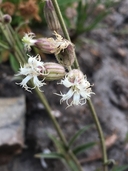Taxon Report
Silene oregana Wats.Oregon campion |
 ©2019 Matt C. Berger |
Taxon Summary
Silene oregana, commonly known as Oregon campion, is a perennial herb in the Caryophyllaceae that is found in California and elsewhere. It occurs within Great Basin scrub, and Subalpine coniferous forest, growing at elevations from 1500 to 2500 meters. Silene oregana is ranked 2B.2, Plants Rare, Threatened, or Endangered in California, But More Common Elsewhere; Moderately threatened in California.Classification
|
Scientific Name: |
Silene oregana Wats. |
|
Common Name: |
Oregon campion |
| Family: | Caryophyllaceae |
| Element Code: | PDCAR0U170 |
| USDA Plants Symbol: | SIOR3 |
|
Synonyms/Other Names: |
|
Ecology and Life History
| Lifeform: | perennial herb |
| Blooming Period: Jul-Sep | Jul-Sep |
| Elevation: | 1500-2500 (4920-8205) |
| General Habitats: | Great Basin scrub, Subalpine coniferous forest |
| Microhabitat: | |
| Microhabitat Details: |
Conservation Status
| CA Rare Plant Rank: | 2B.2 |
| Global Rank: | G4 |
|
State Rank: |
S3 |
| State List: | None |
| Fed List: | None |
| Other Status: | |
|
CRPR Changes: |
|
Occurrence Data from the CNDDB
| Total Occurrences: | 32 |
| Element Occurrence Ranks: | |
| Excellent (A) | 1 |
| Good (B) | 14 |
| Fair (C) | 2 |
| Poor (D) | 1 |
| None (X) | 0 |
| Unknown (U) | 14 |
| California Endemic: False | |
| California Counties and Islands: Name (Code) | |
| Alpine (ALP), Lassen (LAS), Modoc (MOD), Mono (MNO), Shasta (SHA), Tuolumne (TUO) | |
| Quads: Name (Quad Code) | |
| Ambrose Valley (4112027), Davis Creek (4112063), Eagle Peak (4112032), Emerson Peak (4112022), Fredonyer Peak (4012065), Hermit Butte (4112037), Likely (4112025), Manzanita Lake (4012155), Mount Dana (3711982), Pickel Meadow (3811935), Shinn Mtn. (4012062), Sonora Pass (3811936), Soup Creek (4112033), Warren Peak (4112042) | |
Threat List Data from the CNDDB
| Threat List Total: | 5 | |
| EOs with Threat Listed: | Total EOs | % of EOs |
| 16 | 50 % | |
| Foot traffic/trampling | 9 | 28% |
| Logging | 6 | 18% |
| Road/trail construction/maint. | 6 | 18% |
| Grazing | 5 | 15% |
| Recreational use (non-ORV) | 1 | 3% |
Notes
|
Potentially threatened by logging, vehicles, and road/trail maintenance. Possibly threatened by grazing and recreational activities. See Proceedings of the American Academy of Arts and Sciences |
|
Threats: |
|
Taxonomy: |
Selected References
| Silene oregana account for potential Species of Conservation Concern evaluation (2023) |
Citation
California Native Plant Society, Rare Plant Program. 2025. Rare Plant Inventory (online edition, v9.5.1). Website https://www.rareplants.cnps.org [accessed 16 December 2025].